Monitoring of Caged Bluefin Tuna Reactions to Ship and Offshore Wind Farm Operational Noises
Abstract
:1. Introduction
2. Materials and Methods
2.1. Location and Measurement Conditions
2.2. Background Tuna Behavior
2.3. Exposure to Pure Tones, Synthetic Noises, and Hydrophone Recording Playback
2.4. Data Analysis
- Average depth and upper and lower limits of the school;
- Average length of traces;
- Average tilt of traces.
2.5. Statistics Analysis
- B0: No response to stimuli;
- B1: Moderate response, with the tuna presenting slight changes in vertical position, swimming velocity, or swimming tilt.
- B2: Severe response referring to abrupt changes in vertical position, swimming velocity, or swimming tilt.
3. Results
3.1. Background Tuna Behavior
3.2. Reaction of Tuna to Sound Playback
- Duration of the experiment is limited to a maximum of three days to avoid possible cumulative stress and prevent a decrease in tuna meat quality. In the case of a sudden rise in physiological stress indicators, some experimental time must be disposed of to ensure normal conditions before the next slaughter period.
- Maximum acoustic levels to which the tuna are commonly exposed to at the feeding installations are not exceeded.
- The ship arrived everyday early in the morning and was moored alongside the experiment cage.
- The recording system was set up, and feeding boats approached recording tuna reactions.
- During the feeding operations, the ship’s engine was turned on to achieve maximum battery charge. The sound projector was set up.
- All measurements related to recording playbacks were developed in absence of the ship’s noise (or alternator noise) in the proximity of the cage.
- Average background measurements suggested that SPL was around 93 dB ref 1 Pa with peaks lower than 100 dB ref 1 Pa below 1 kHz. (see Figure 8 for details).
- The experiment was performed over two daily periods after tuna feeding (morning and afternoon–evening) and was repeated for 3 days.
3.3. Day 1 Results
3.4. Day 2 Results
3.5. Day 3 Results: Windmill Recorded Playback Increases Exposure
- School depth: a few minutes after starting the noise emission, the school moved upward (see Figure 14). The tuna remained closer to the surface even when acoustic emissions had finished, and only some minutes later did they recover their original distribution.
- Swimming pattern size and position: the tuna bunched together and swam closer to one to each other. They still acted like a school with a circular pattern but displaying circles of a smaller radius and occupying only half of the cage (see Figure 15).
- Swimming direction: to identify possible changes in swimming direction, ten random intervals of five minutes of video recordings were analyzed before and after long acoustic emissions. During the intervals before the emission, none of the tuna changed their swimming direction from that of the school. However, after a long noise emission, an average of 15 tuna individuals were registered to swim in the opposite direction at a higher speed. This reaction was observed in addition to the two changes described above.
3.6. Statistics Analysis Results
4. Discussion
- (i)
- Position change in the water column of the fish school.
- (ii)
- Increase in school activity: contraction and expansion of the school (alarm).
- (iii)
- Displacement and contraction of the school (avoidance).
- (iv)
- After the longest emissions, some specimens swam in the opposite direction to the rest of school, which could be interpreted as slight disorientation.
- (v)
- Increased speed.
Author Contributions
Funding
Institutional Review Board Statement
Informed Consent Statement
Acknowledgments
Conflicts of Interest
References
- Tournadre, J. Anthropogenic pressure on the open ocean: The growth of ship traffic revealed by altimeter data analysis. Geophys. Res. Lett. 2014, 41, 7924–7932. [Google Scholar] [CrossRef] [Green Version]
- Technical Guidance for Assessing the Effects of Anthropogenic Sound on Marine Mammal Hearing (Version 2.0): Underwater Thresholds for Onset of Permanent and Temporary Threshold Shifts; National Marine Fisheries Service: Silver Spring, MD, USA, 2018; pp. 1–167.
- Dekeling, R.P.A.; Tasker, M.L.; Van der Graaf, A.J.; Ainslie, M.A.; Andersson, M.H.; André, M.; Borsani, J.F.; Brensing, K.; Castellote, M.; Cronin, D.; et al. Monitoring Guidance for Underwater Noise in European Seas-Part II: Monitoring Guidance Specifications; Publications Office of the European Union: Luxembourg, 2014. [Google Scholar]
- Peng, C.; Zhao, X.; Liu, G. Noise in the Sea and Its Impacts on Marine Organisms. Int. J. Environ. Res. Public Health 2015, 12, 12304–12323. [Google Scholar] [CrossRef] [PubMed] [Green Version]
- Fay, R.R.; Popper, A.N. Evolution and hearing in vertebrates: The inner ears and processing. Hear. Res. 2000, 149, 1–10. [Google Scholar] [CrossRef]
- Popper, A.N.; Hawkins, A.D. An overview of fish bioacoustics and the impacts of anthropogenic sounds on fishes. J. Fish Biol. 2019, 94, 692–713. [Google Scholar] [CrossRef] [Green Version]
- Kasumyan, A.O. Structure and function of the auditory system in fishes. J. Ichthyol. 2005, 45, 223–270. [Google Scholar]
- Nedwell, J.R.; Turnpenny, A.; Langworthy, J.; Edwards, B. Measurements of Underwater Noise during Piling at the Red Funnel Terminal, Southampton, and Onservations of Its Effect on Caged Fish; Subacoustech Ltd.: Hampshire, UK, 2003; Volume 558. [Google Scholar]
- Ruggerone, G.T.; Goodman, S.E.; Miner, R. Behavioral Response and Survival of Juvenile Coho Salmon to Pile Driving Sounds; Natural Resources Consultants, Inc.: Seattle, WA, USA, 2008. [Google Scholar]
- Pile Installation Demonstration Project, Fisheries Impact Assessment; San Francisco Oakland Bay Bridge East Span Seismic Safety Project; Caltran: San Francisco, CA, USA, 2001.
- Madsen, P.T.; Wahlberg, M.; Tougaard, J.; Lucke, K.; Tyack, A.P. Wind turbine underwater noise and marine mammals: Implications of current knowledge and data needs. Mar. Ecol. Prog. Ser. 2006, 309, 279–295. [Google Scholar] [CrossRef]
- Bailey, H.; Brookes, K.L.; Thompson, P.M. Assessing environmental impacts of offshore wind farms: Lessons learned and recommendations for the future. Aquat. Biosyst. 2014, 10, 1–13. [Google Scholar] [CrossRef] [Green Version]
- Tougaard, J.; Hermannsen, L.; Madsen, P.T. How loud is the underwater noise from operating offshore wind turbines? J. Acoust. Soc. Am. 2020, 148, 2885. [Google Scholar] [CrossRef]
- Mooney, T.A.; Andersson, M.H.; Stanley, J. Acoustic Impacts of Offshore Wind Energy on Fishery Resources: An Evolving Source and Varied Effects across a Wind Farm’s Lifetime. Oceanography 2020, 33, 82–95. [Google Scholar] [CrossRef]
- Farr, H.; Ruttenberg, B.; Walter, R.K.; Wang, Y.H.; White, C. Potential environmental effects of deepwater floating offshore wind energy facilities. Ocean Coast. Manag. 2021, 207, 105611. [Google Scholar] [CrossRef]
- Dale, J.J.; Gray, M.D.; Popper, A.N.; Rogers, P.H.; Block, B.A. Hearing thresholds of swimming Pacific bluefin tuna Thunnus orientalis. J. Comp. Physiol. A 2015, 201, 441–454. [Google Scholar] [CrossRef] [PubMed]
- Hawkins, A.D.; Roberts, L.; Cheesman, S. Responses of free-living coastal pelagic fish to impulsive sounds. J. Acoust. Soc. Am. 2014, 135, 3101–3116. [Google Scholar] [CrossRef] [Green Version]
- Wisniewska, D.M.; Teilmann, J.; Hermannsen, L.; Johnson, M.; Miller, L.A.; Siebert, U.; Madsen, P.T. Quantitative Measures of Anthropogenic Noise on Harbor Porpoises: Testing the Reliability of Acoustic Tag Recordings. Adv. Exp. Med. Biol. 2016, 875, 1237–1242. [Google Scholar] [PubMed]
- van Beest, F.M.; Teilmann, J.; Hermannsen, L.; Galatius, A.; Mikkelsen, L.; Sveegaard, S.; Balle, J.D.; Dietz, R.; Nabe-Nielsen, J. Fine-scale movement responses of free-ranging harbour porpoises to capture, tagging and short-term noise pulses from a single airgun. R. Soc. Open Sci. 2018, 5, 170110. [Google Scholar] [CrossRef] [PubMed] [Green Version]
- Hoyle, S.D.; Leroy, B.M.; Nicol, S.J.; Hampton, W.J. Covariates of release mortality and tag loss in large-scale tuna tagging experiments. Fish. Res. 2015, 163, 106–118. [Google Scholar] [CrossRef]
- Doksæter, L.; Handegard, N.O.; Godø, O.R.; Kvadsheim, P.H.; Nordlund, N. Behavior of captive herring exposed to naval sonar transmissions (1.0–1.6 kHz) throughout a yearly cycle. J. Acoust. Soc. Am. 2012, 131, 1632. [Google Scholar] [CrossRef]
- Allen, S.; Demer, D.A. Detection and characterization of yellowfin and bluefin tuna using passive-acoustical techniques. Fish. Res. 2003, 63, 393–403. [Google Scholar] [CrossRef]
- Stan, G.-B.; Embrechts, J.-J.; Archambeau, D. Comparison of different impulse response measurement techniques. J. Audio Eng. Soc. 2002, 50, 249–262. [Google Scholar]
- Urmy, S.S.; Horne, J.K.; Barbee, D.H. Measuring the vertical distributional variability of pelagic fauna in Monterey Bay. ICES J. Mar. Sci. 2014, 69, 184–196. [Google Scholar] [CrossRef] [Green Version]
- Otsu, N.A. Threshold Selection Method from Gray-Level Histograms. IEEE Trans. Syst. Man. Cybern 1979, 9, 62–66. [Google Scholar] [CrossRef] [Green Version]
- Puig-Pons, V.; Muñoz-Benavent, P.; Espinosa, V.; Andreu-García, G.; Valiente-González, J.; Estruch, V.; Ordóñez, P.; Pérez-Arjona, I.; Atienza, V.; Mèlich, B.; et al. Automatic Bluefin Tuna (Thunnus thynnus) biomass estimation during transfers using acoustic and computer vision techniques. Aquac. Eng. 2019, 85, 22–31. [Google Scholar] [CrossRef]
- La Manna, G.; Manghi, M.; Perretti, F.; Sarà, G. Behavioral response of brown meagre (Sciaena umbra) to boat noise. Mar. Pollut. Bull. 2016, 110, 324–334. [Google Scholar] [CrossRef] [PubMed]
- Herbert-Read, J.E.; Kremer, L.; Bruintjes, R.; Radford, A.N.; Ioannou, C.C. Anthropogenic noise pollution from pile-driving disrupts the structure and dynamics of fish shoals. Proc. R. Soc. Biol. Sci. 2017, 284, 20171627. [Google Scholar] [CrossRef] [Green Version]
- StatPoint Technologies, Inc. Statgraphics Centurion XVIII; StatPoint Technologies, Inc.: Warrenton, VA, USA, 2021. [Google Scholar]
- Komeyama, K.; Kadota, M.; Torisawa, S.; Suzuki, K.; Tsuda, Y.; Takagi, T. Measuring the Swimming Behaviour of a Reared Pacific Bluefin Tuna in a Submerged Aquaculture Net Cage. Aquat. Living Resour. 2011, 24, 99–105. [Google Scholar] [CrossRef] [Green Version]
- Komeyama, K.; Kadota, M.; Torisawa, S.; Takagi, T. Three-Dimensional Trajectories of Cultivated Pacific Bluefin Tuna Thunnus Orientalis in an Aquaculture Net Cage. Aquac. Environ. Interact. 2013, 4, 81–90. [Google Scholar] [CrossRef]
- Nucci, M.E.; Costa, C.; Scardi, M.; Cataudella, S. Preliminary observations on bluefin tuna (Thunnus thynnus, Linnaeus 1758) behaviour in captivity. J. Appl. Ichthyol. 2010, 26, 95–98. [Google Scholar] [CrossRef]
- Sarà, G.; Dean, J.M.; d’Amato, D.; Buscaino, G.; Oliveri, A.; Genovese, S.; Ferro, S.; Buffa, G.; Martire, M.L.; Mazzola, S. Effect of boat noise on the behaviour of bluefin tuna Thunnus Thynnus in the Mediterranean Sea. Mar. Ecol. Prog. Ser. 2007, 331, 243–253. [Google Scholar] [CrossRef] [Green Version]
- Popper, A.N.; Schilt, C.R. Hearing and Acoustic Behavior: Basic and Applied Considerations. Fish Bioacoust. 2008, 32, 17–48. [Google Scholar]
- Popper, A.N.; Hastings, M.C. The effects of anthropogenic sources of sound on fishes. J. Fish Biol. 2009, 75, 455–489. [Google Scholar] [CrossRef]
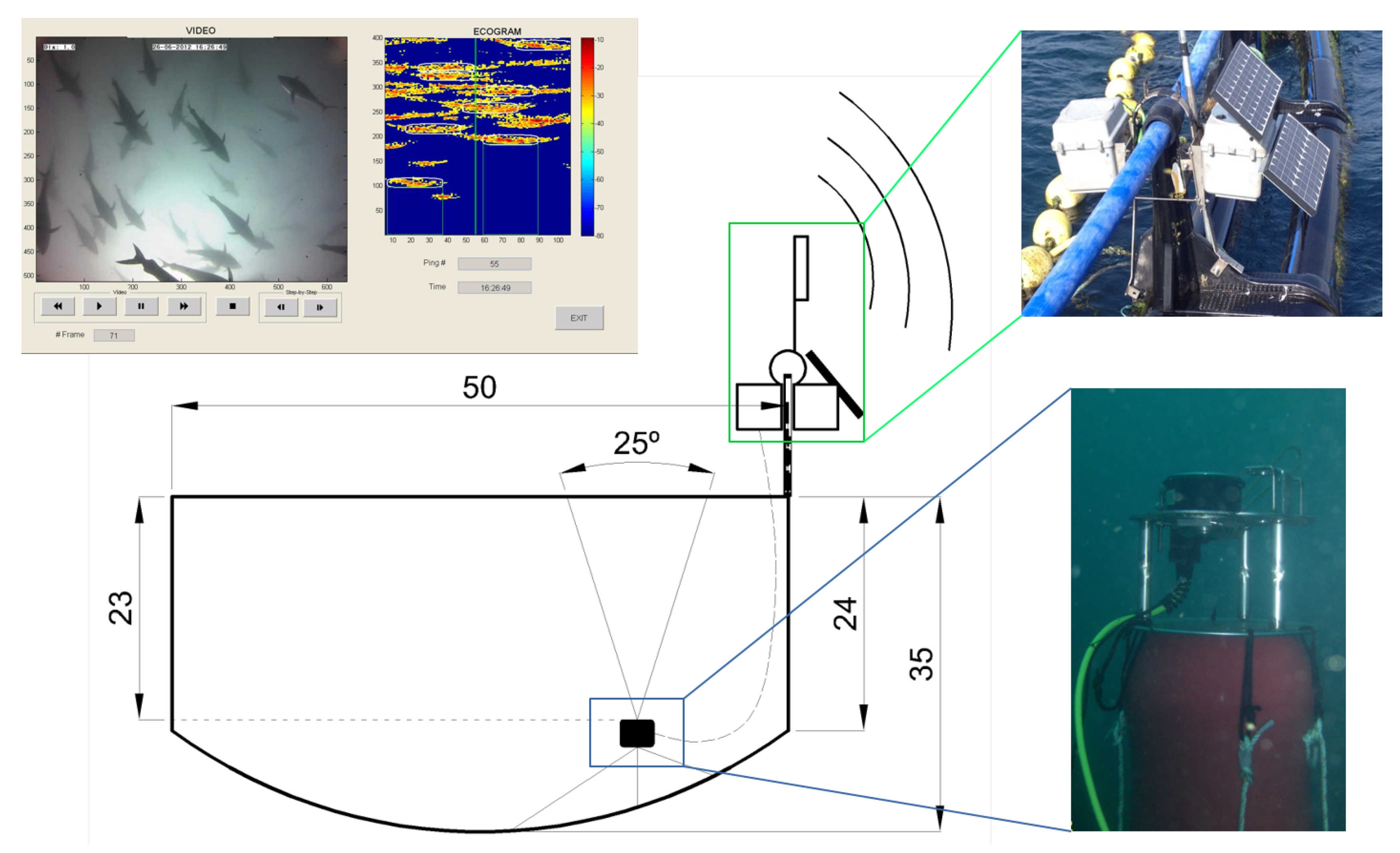
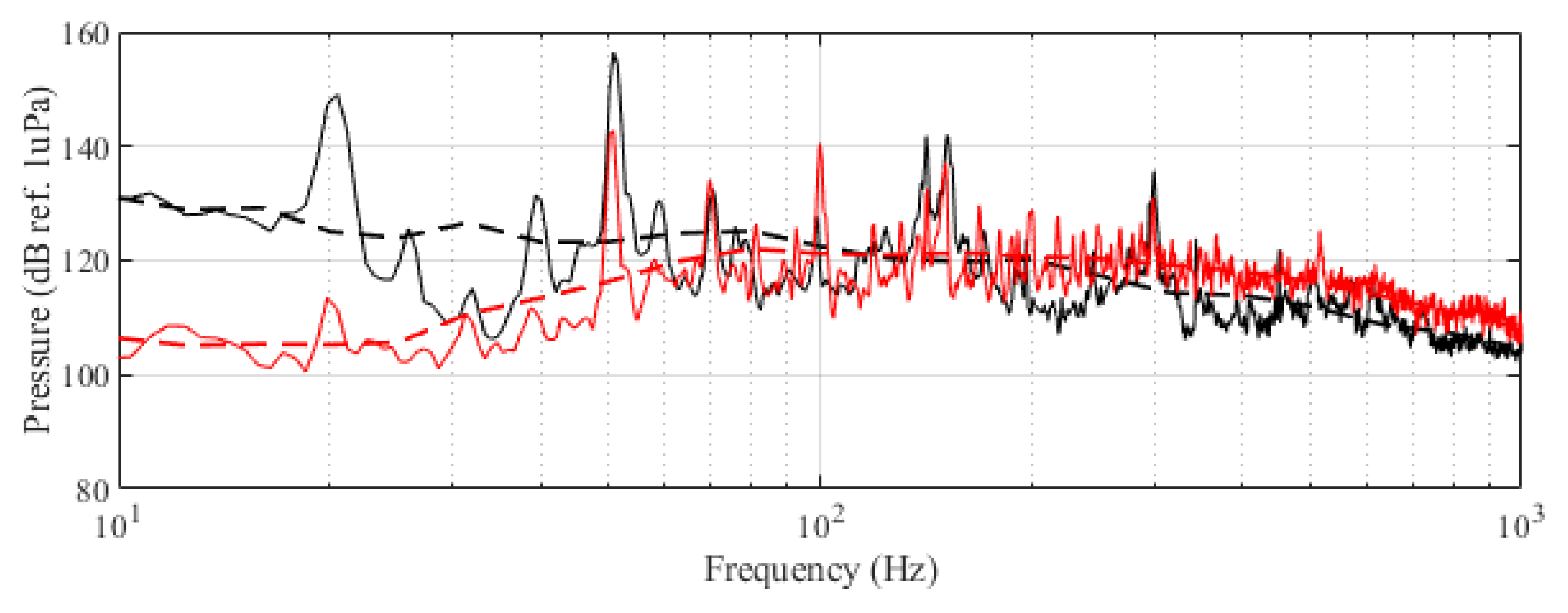
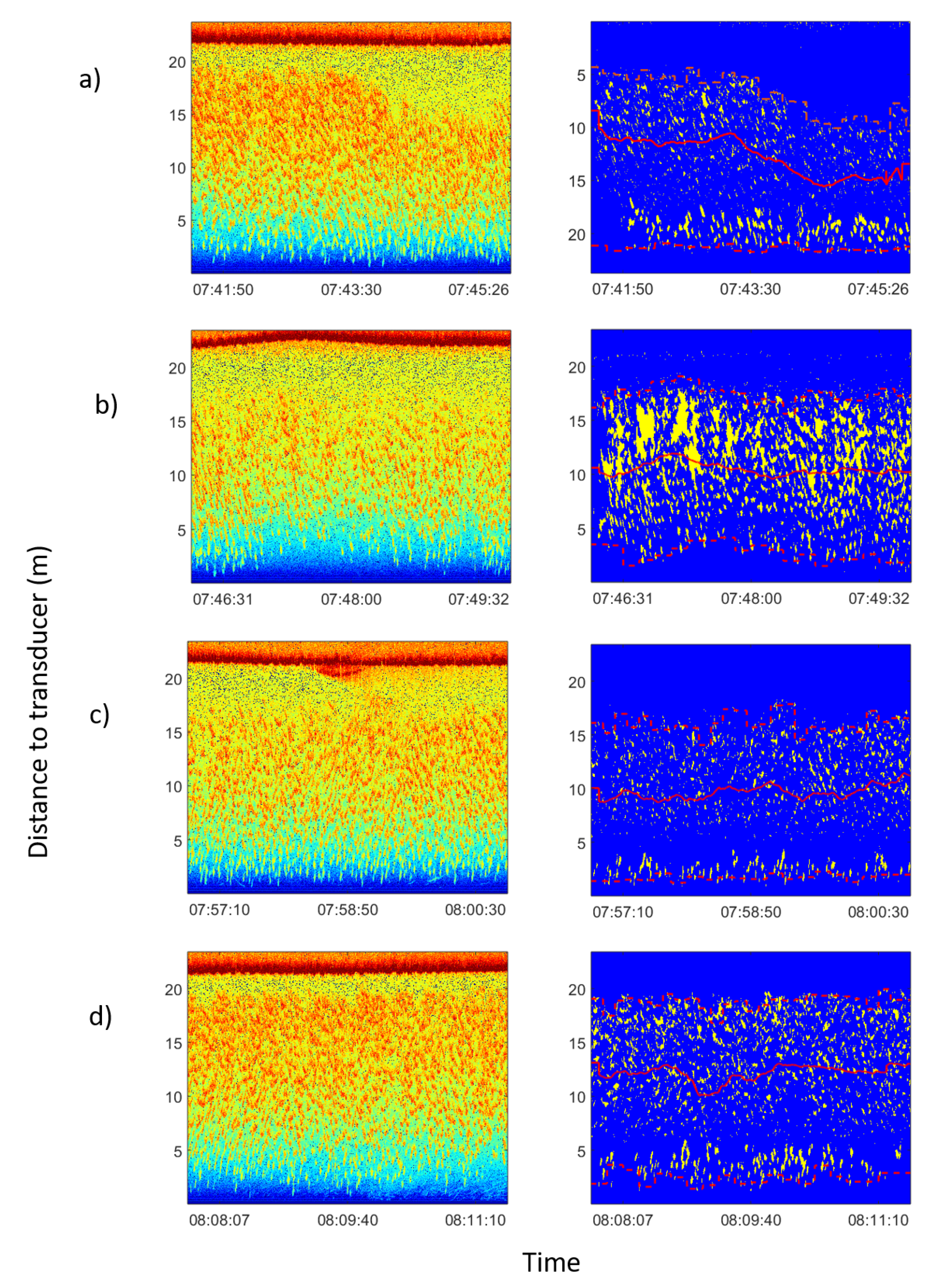
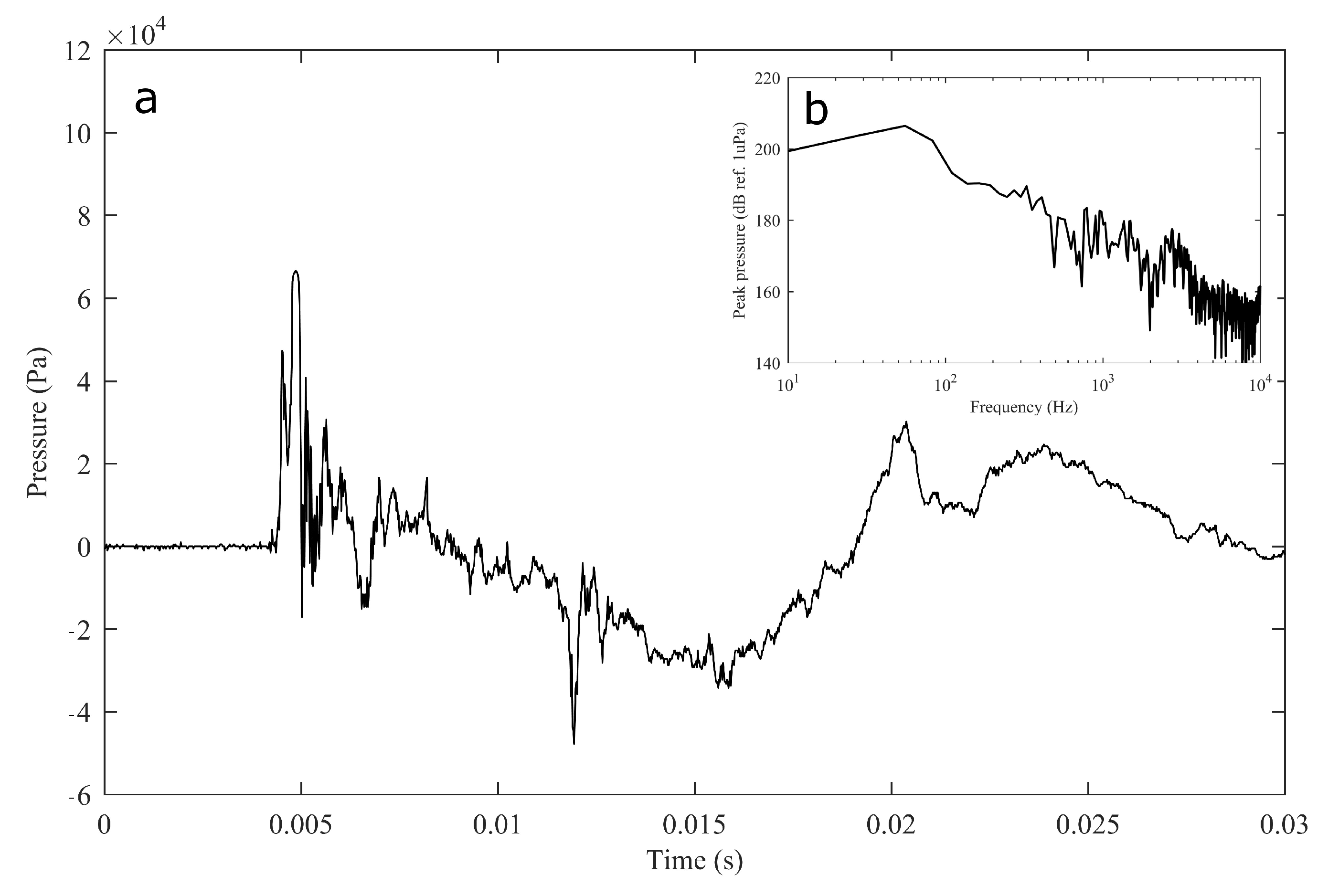
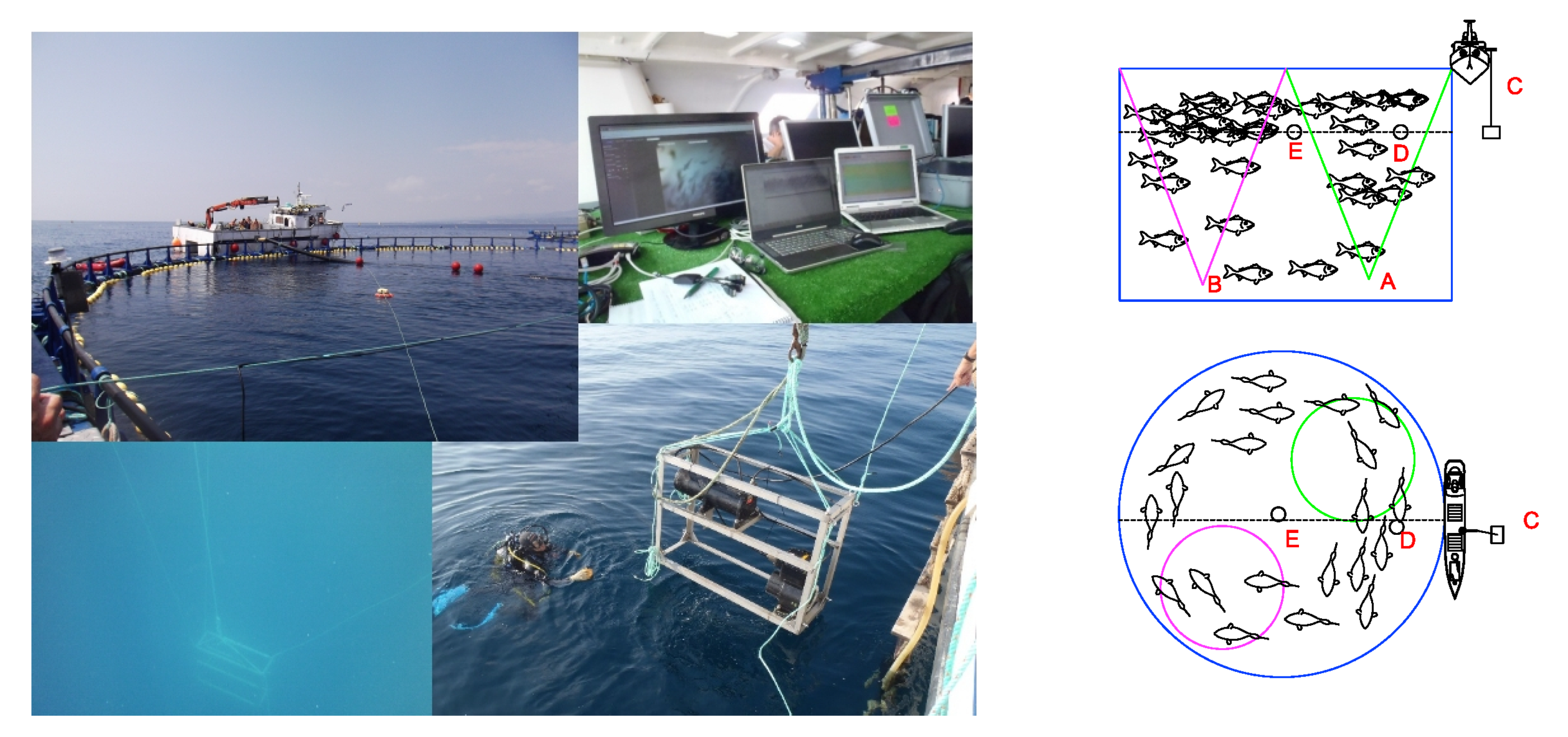
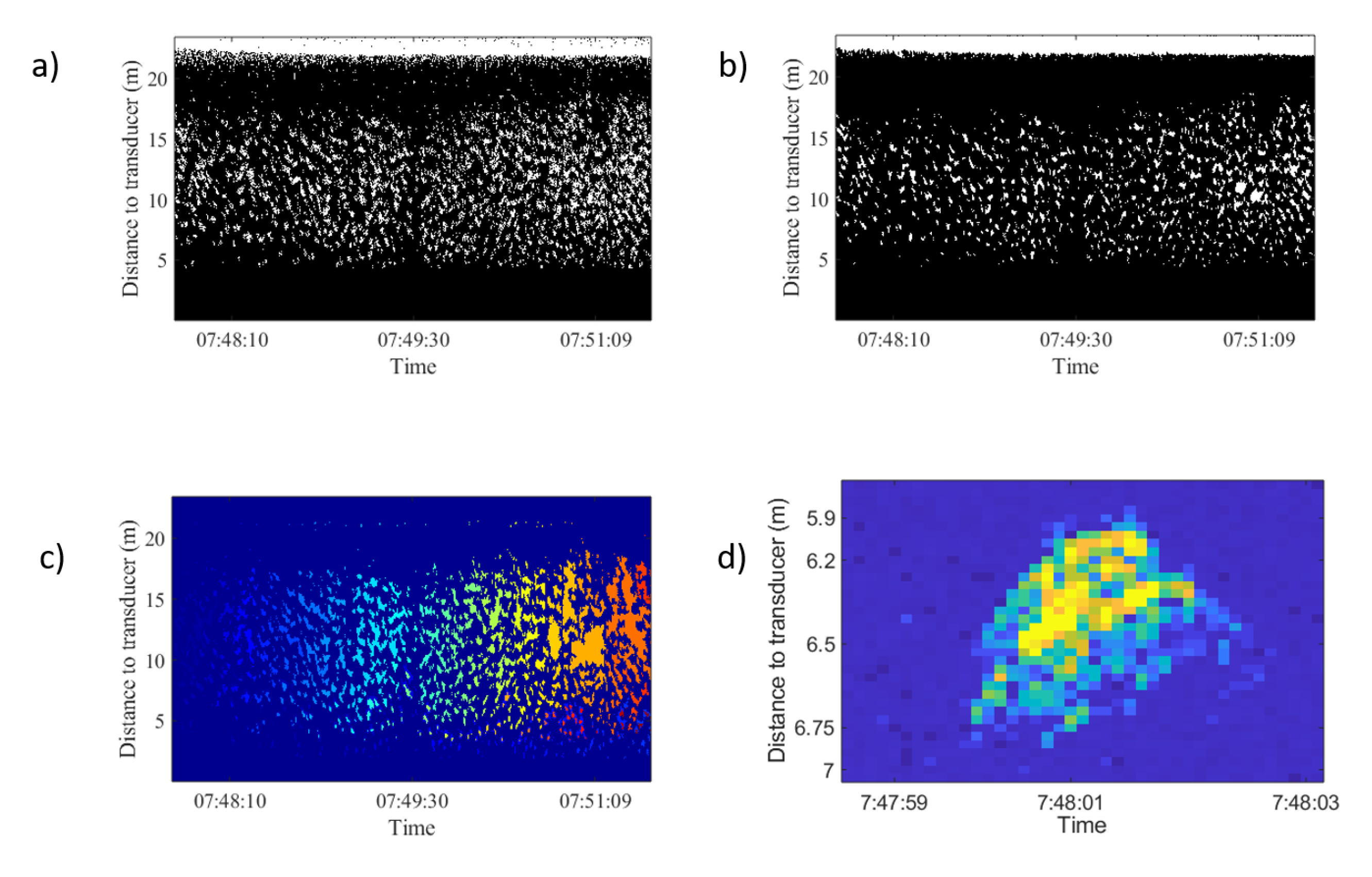
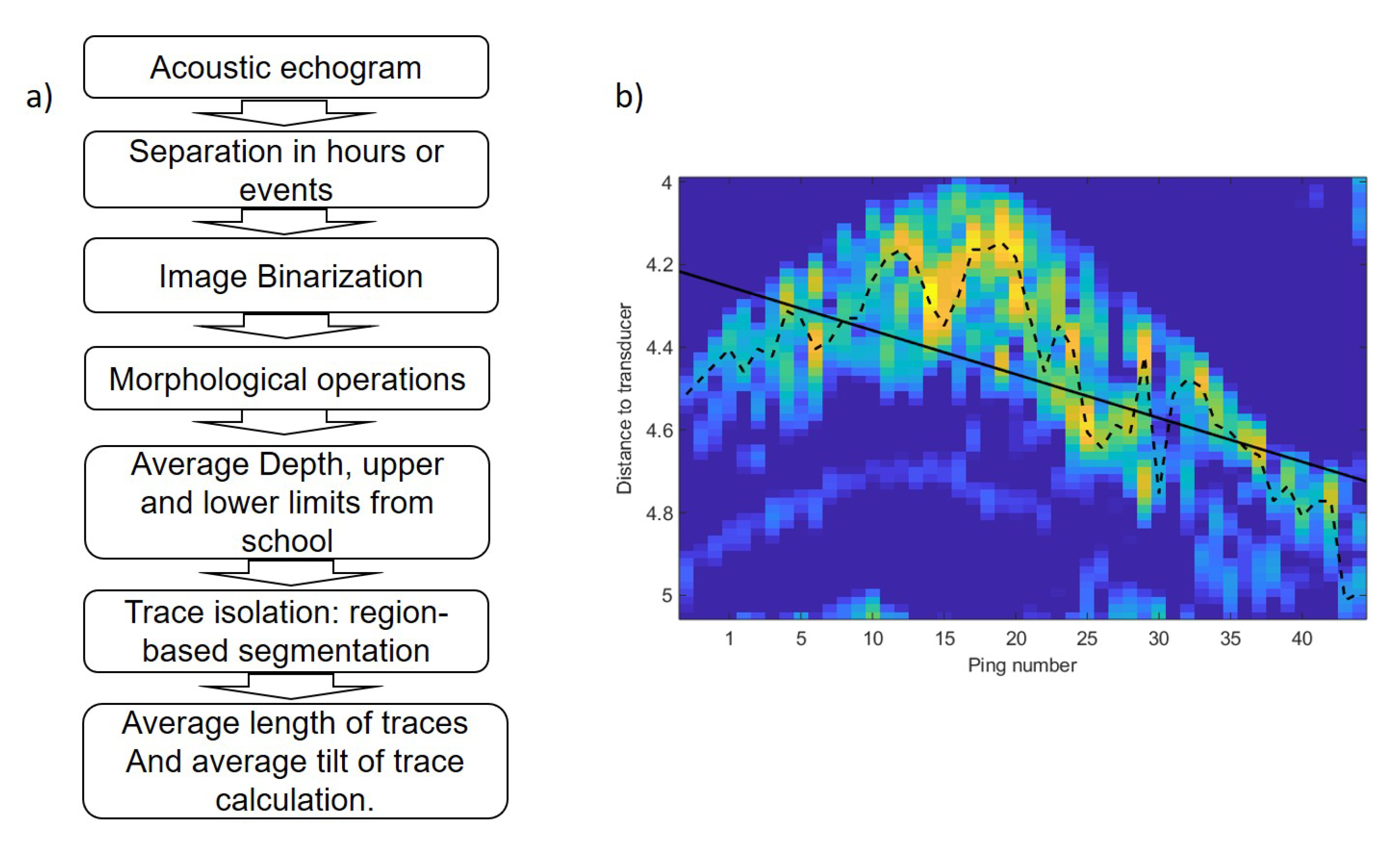
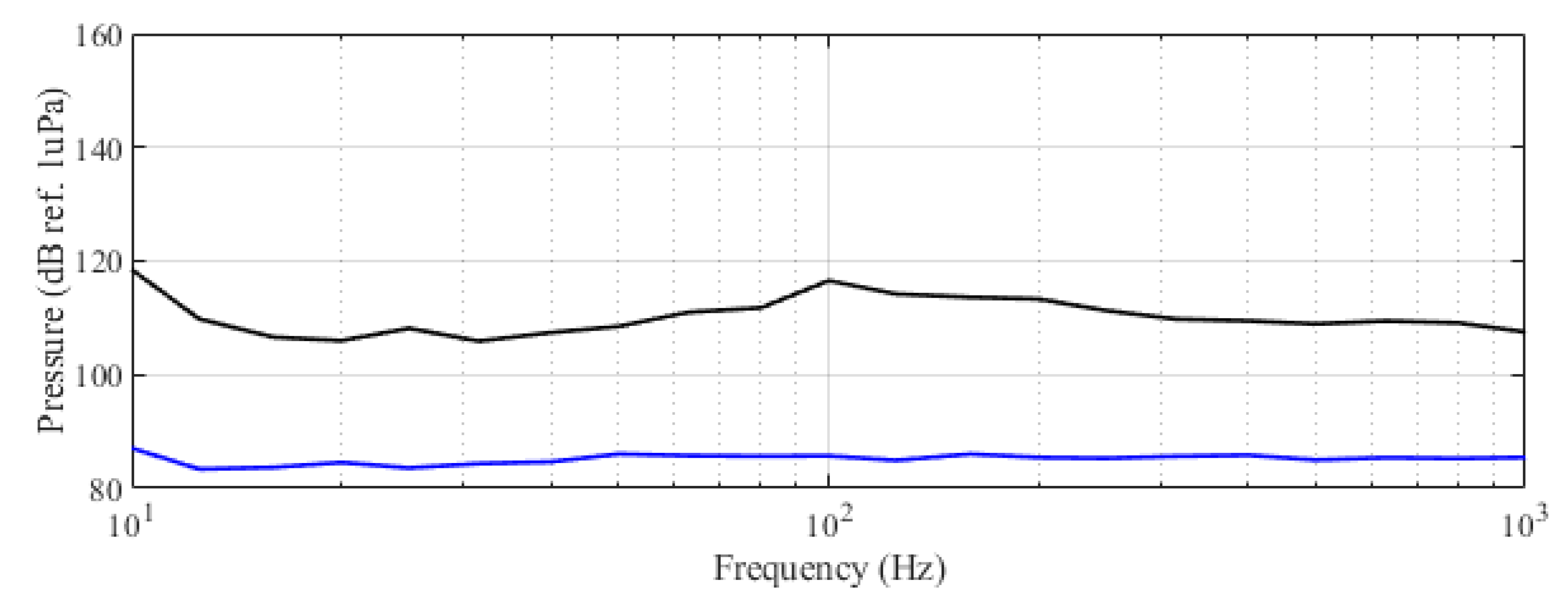
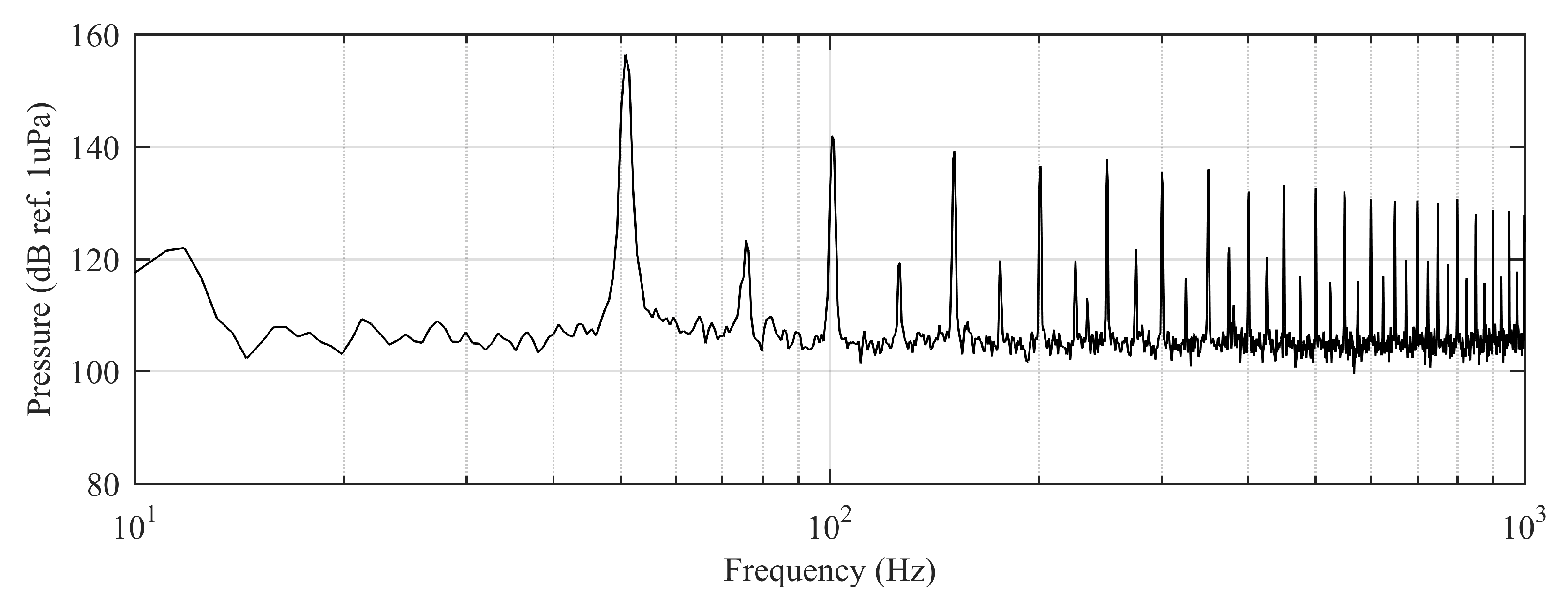
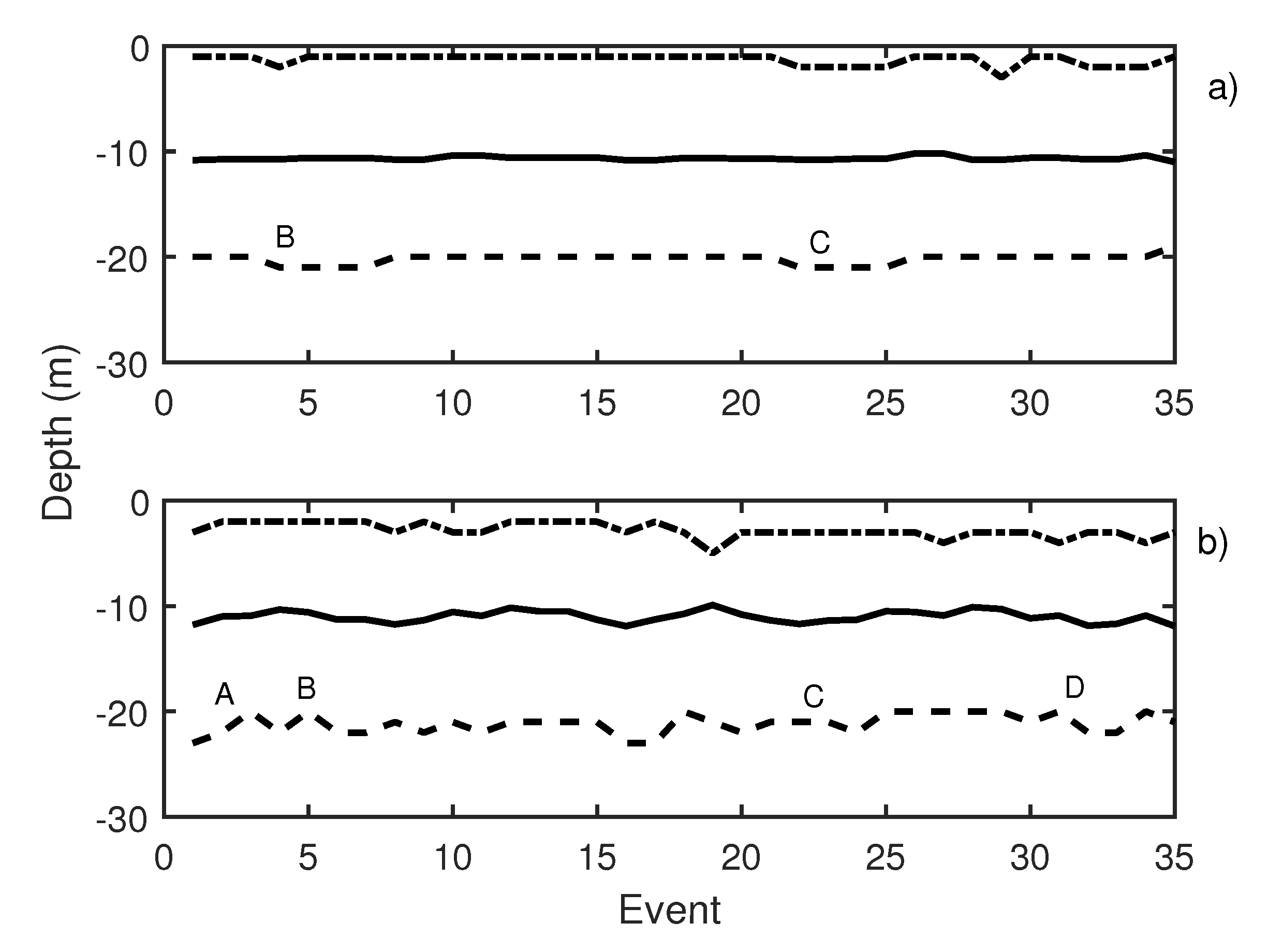



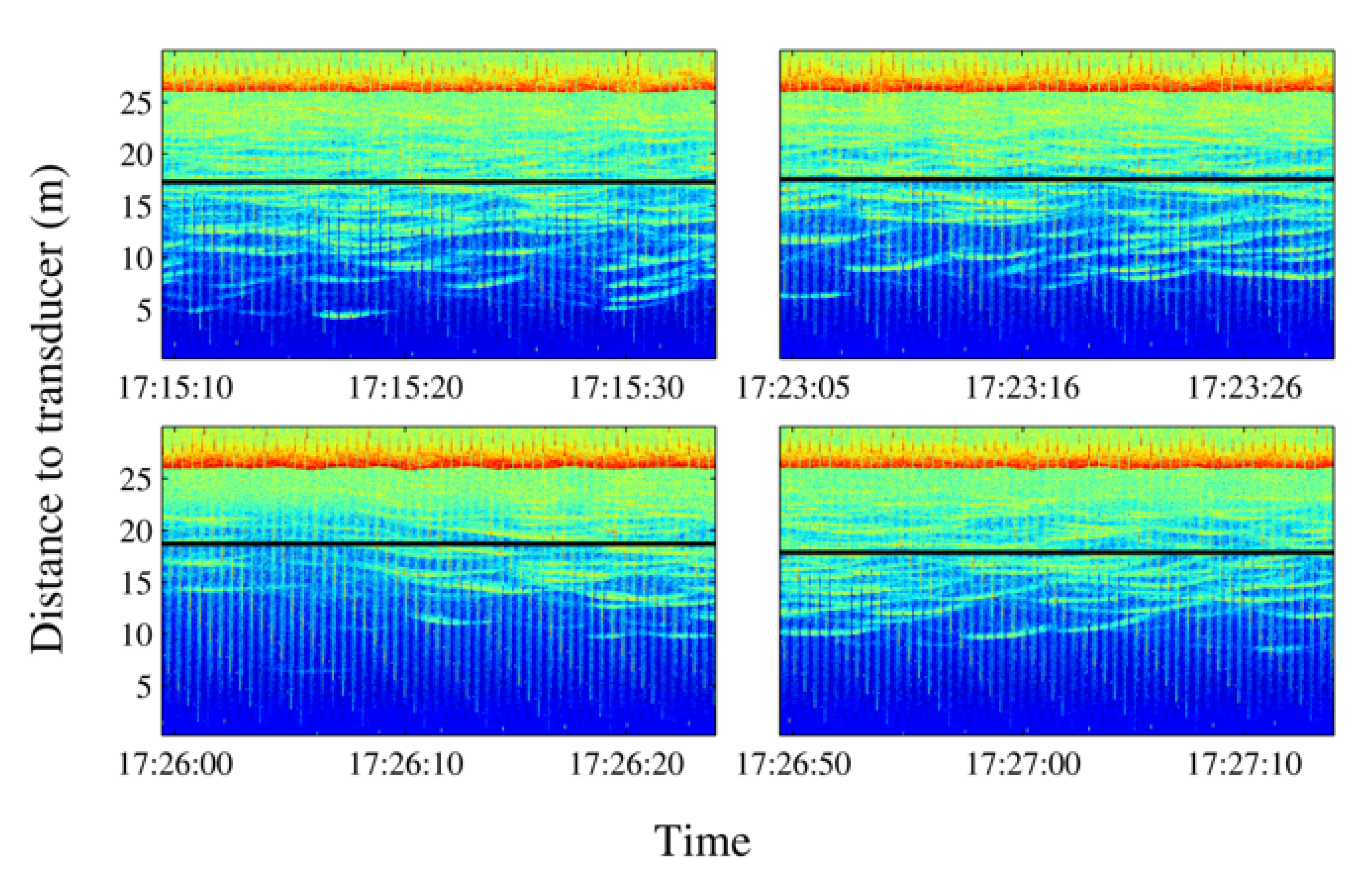
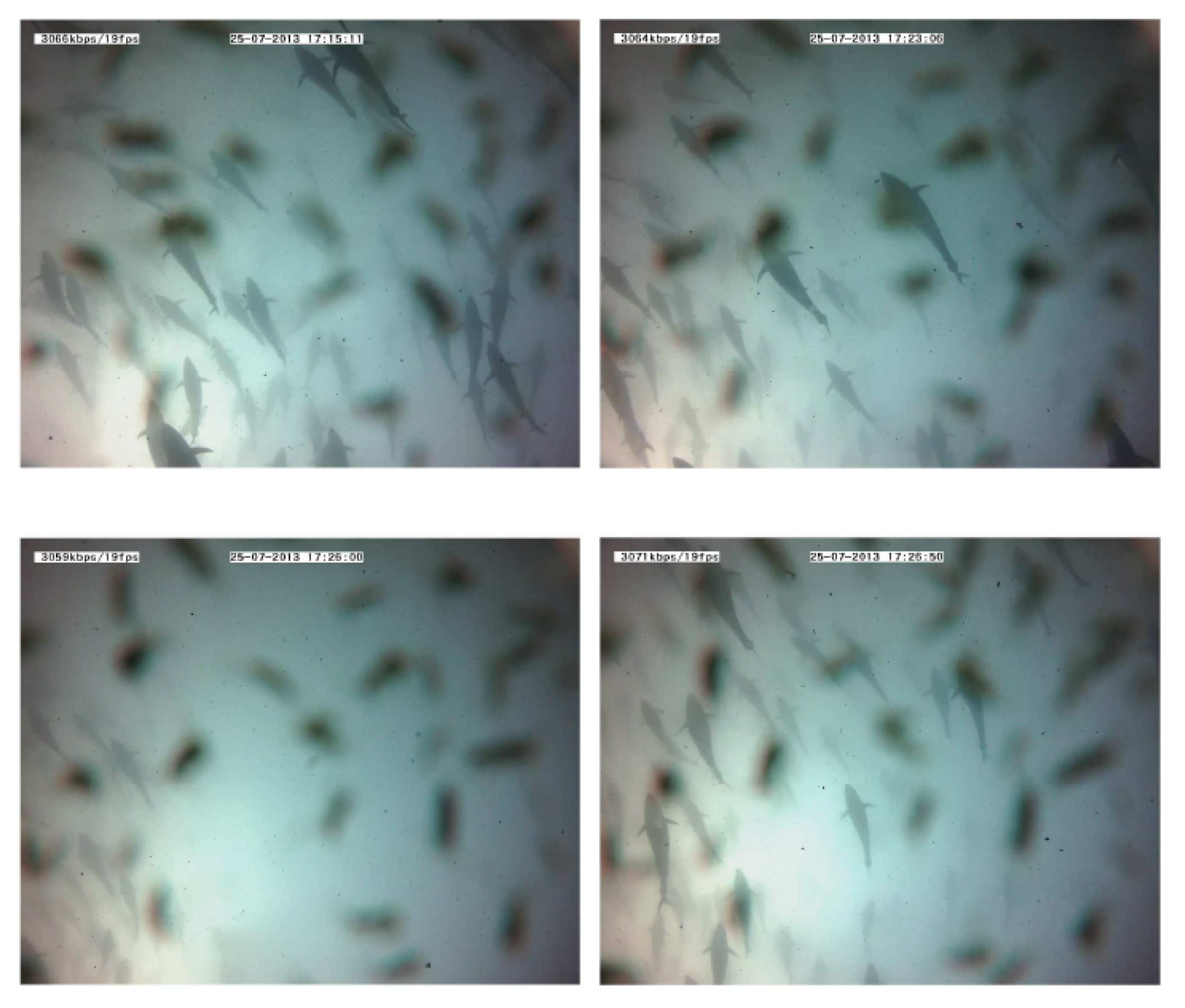
| Label | Event | Emitted Signal | Average Trace Length | Swimming Tilt (*) |
|---|---|---|---|---|
| A | 1 to 3 | 1000 Hz | 20 pings | up |
| B | 4 to 8 | 20 Hz | 15 pings | up/down |
| C | 20 to 23 | 500 Hz | 15 pings | up/down |
| D | 30 to 34 | Windmill | 15 pings | up/down |
| Label | Event | Emitted Signal | Average Trace Length | Swimming Tilt (*) |
|---|---|---|---|---|
| A | 3 to 11 | 19 Hz, 50 Hz, and 300 Hz | 14 pings | down/up/down |
| B | 12 to 13 | lupara | 11 pings | down/up |
| C | 14 to 25 | broadband noises | 15 pings | down/up |
| D | 38 to 40 | 50 Hz | 10 pings | up/down |
| Label | Event | Emitted Signal | Average Trace Length | Swimming Tilt (*) |
|---|---|---|---|---|
| A | 5 to 9 | 30 Hz, 50 Hz, and 150 Hz | 14 pings | up/down/up/down |
| B | 11 | windmill 15″ | 10 pings | down/up/down |
| C | 24 | windmill 15′ | 7 pings | up/down |
| D | 25 | windmill 15′ | 8 pings | up/down |
| Source | MS | df | AF | p (*) |
|---|---|---|---|---|
| Upper limit | ||||
| Source type | 4.667 | 6 | 1.182 | 0.323 |
| Source level | 22.340 | 3 | 11.318 | 0.000 |
| Source type × source level | 0.375 | 4 | 0.142 | 0.966 |
| Residuals | 61.847 | 94 | ||
| Lower limit | ||||
| Source type | 41.158 | 6 | 1.507 | 0.184 |
| Source level | 41.214 | 3 | 3.017 | 0.034 |
| Source type × source level | 14.326 | 4 | 0.951 | 0.438 |
| Residuals | 427.981 | 94 | ||
| Average depth | ||||
| Source type | 55.048 | 6 | 5.797 | 0.000 |
| Source level | 27.899 | 3 | 5.876 | 0.001 |
| Source type × source level | 5.171 | 4 | 0.817 | 0.518 |
| Residuals | 15.5756 | 94 | ||
| Average length of traces | ||||
| Source type | 1551.111 | 6 | 0.977 | 0.445 |
| Source level | 24,558.073 | 3 | 30.939 | 0.000 |
| Source type × source level | 2663.504 | 4 | 2.517 | 0.046 |
| Residuals | 24,870.886 | 94 | ||
| Average tilt of traces | ||||
| Source type | 186.391 | 6 | 14.471 | 0.000 |
| Source level | 17.505 | 3 | 2.718 | 0.049 |
| Source type × source level | 39.136 | 4 | 4.558 | 0.002 |
| Residuals | 201.78 | 94 |
| Source Level | N | Subset 1 (**) | Subset 2 (**) |
|---|---|---|---|
| Very high (SPL > 170 dB ref 1 Pa) | 30 | 47.13 | |
| High (SPL = 150–165 dB ref 1 Pa) | 53 | 93.04 | |
| Medium (SPL = 140–150 dB ref 1 Pa) | 15 | 79.40 | |
| Low (SPL 120–140 dB ref 1 Pa) | 9 | 75.56 | |
| Background (SPL < 120 dB ref 1 Pa) | 2 | 77.00 | |
| Sig. | 1.000 | 0.312 |
| Source Level | N | Subset 1 (**) | Subset 2 (**) |
|---|---|---|---|
| Very high (SPL > 170 dB ref 1 Pa) | 30 | 1.0367 | |
| High (SPL = 150–165 dB ref 1 Pa) | 53 | 2.7811 | |
| Medium (SPL = 140–150 dB ref 1 Pa) | 15 | 0.9053 | |
| Low (SPL = 120–140 dB ref 1 Pa) | 9 | 0.8789 | |
| Background (SPL < 120 dB ref 1 Pa) | 2 | −4.3500 | |
| Sig. | 1.000 | 0.428 |
| Source Type | N | Subset 1 (**) | Subset 2 (**) |
|---|---|---|---|
| Tone | 72 | −9.6147 | |
| Windmill | 23 | −9.3226 | |
| Lupara | 2 | −9.2800 | |
| Background | 2 | −8.1850 | −8.1850 |
| Two-tone | 6 | −8.1017 | −8.1017 |
| Chirp | 2 | −5.8950 | |
| Sig. | 0.747 | 0.313 |
| Source Type | N | Subset 1 (**) | Subset 2 (**) |
|---|---|---|---|
| Tone | 72 | 1.3582 | |
| Windmill | 23 | 3.1565 | |
| Lupara | 2 | 4.8000 | |
| Background | 2 | −4.3500 | |
| Two-tone | 6 | 3.5333 | |
| Chirp | 2 | 4.5000 | |
| Sig. | 1.000 | 0.123 |
| Source | MS | df | AF | p (*) |
|---|---|---|---|---|
| BO | ||||
| Source type | 1.155 | 1 | 0.07 | 0.835 |
| Source level | 1.108 | 1 | 0.07 | 0.838 |
| Source type × Source level | 0 | 0 | 0 | – |
| Residuals | 16.368 | 1 | ||
| B1 | ||||
| Source type | 261.8 | 14 | 2.71 | 0.006 |
| Source level | 867.64 | 3 | 41.98 | 0.800 |
| Source type × Source level | 171.7 | 18 | 1.38 | 0.189 |
| Residuals | 289.33 | 42 | ||
| B2 | ||||
| Source type | 211.401 | 10 | 1.57 | 0.235 |
| Source level | 89.385 | 1 | 1.63 | 0.125 |
| Source type × Source level | 24.93 | 2 | 0.92 | 0.4253 |
| Residuals | 148.239 | 11 |
Publisher’s Note: MDPI stays neutral with regard to jurisdictional claims in published maps and institutional affiliations. |
© 2021 by the authors. Licensee MDPI, Basel, Switzerland. This article is an open access article distributed under the terms and conditions of the Creative Commons Attribution (CC BY) license (https://creativecommons.org/licenses/by/4.0/).
Share and Cite
Puig-Pons, V.; Soliveres, E.; Pérez-Arjona, I.; Espinosa, V.; Poveda-Martínez, P.; Ramis-Soriano, J.; Ordoñez-Cebrián, P.; Moszyński, M.; de la Gándara, F.; Bou-Cabo, M.; et al. Monitoring of Caged Bluefin Tuna Reactions to Ship and Offshore Wind Farm Operational Noises. Sensors 2021, 21, 6998. https://doi.org/10.3390/s21216998
Puig-Pons V, Soliveres E, Pérez-Arjona I, Espinosa V, Poveda-Martínez P, Ramis-Soriano J, Ordoñez-Cebrián P, Moszyński M, de la Gándara F, Bou-Cabo M, et al. Monitoring of Caged Bluefin Tuna Reactions to Ship and Offshore Wind Farm Operational Noises. Sensors. 2021; 21(21):6998. https://doi.org/10.3390/s21216998
Chicago/Turabian StylePuig-Pons, Vicente, Ester Soliveres, Isabel Pérez-Arjona, Victor Espinosa, Pedro Poveda-Martínez, Jaime Ramis-Soriano, Patricia Ordoñez-Cebrián, Marek Moszyński, Fernando de la Gándara, Manuel Bou-Cabo, and et al. 2021. "Monitoring of Caged Bluefin Tuna Reactions to Ship and Offshore Wind Farm Operational Noises" Sensors 21, no. 21: 6998. https://doi.org/10.3390/s21216998
APA StylePuig-Pons, V., Soliveres, E., Pérez-Arjona, I., Espinosa, V., Poveda-Martínez, P., Ramis-Soriano, J., Ordoñez-Cebrián, P., Moszyński, M., de la Gándara, F., Bou-Cabo, M., Cort, J. L., & Santaella, E. (2021). Monitoring of Caged Bluefin Tuna Reactions to Ship and Offshore Wind Farm Operational Noises. Sensors, 21(21), 6998. https://doi.org/10.3390/s21216998









